Looking Forward to 2010
January 19, 2010
The celebration of UC San Diego's 50th anniversary as well as the development of six major construction projects will highlight the 2010 year on campus. The university also will begin energy-saving retrofits of 25 older buildings that will take four years to complete. This new year promises to be one of both exciting developments and financial challenges. This Week@UCSD asked each of the campus divisions about what they have in store for the next 12 months.
Campus to Celebrate 50 Years of Achieving the Extraordinary
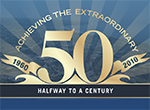 UC San Diego will mark its 50th anniversary (www.50th.ucsd.edu) in 2010-2011 with festivities celebrating our last half century of achievement and heralding our next 50 years. And to ensure that UC San Diego remains affordable in the years to come, the campus has launched a three-year, $50 million “Invent the Future” student support campaign (www.InventTheFuture.ucsd.edu) that will fund undergraduate scholarships and graduate fellowships. UC San Diego will also lead the county’s largest celebration of science with the 2010 San Diego Science Festival (www.sdsciencefestival.com), featuring a week of free science activities and events beginning March 20 and culminating in Expo Day at PETCO Park March 27 where attendees will “excite their minds” with hands-on exhibits and experiments. UC San Diego will mark its 50th anniversary (www.50th.ucsd.edu) in 2010-2011 with festivities celebrating our last half century of achievement and heralding our next 50 years. And to ensure that UC San Diego remains affordable in the years to come, the campus has launched a three-year, $50 million “Invent the Future” student support campaign (www.InventTheFuture.ucsd.edu) that will fund undergraduate scholarships and graduate fellowships. UC San Diego will also lead the county’s largest celebration of science with the 2010 San Diego Science Festival (www.sdsciencefestival.com), featuring a week of free science activities and events beginning March 20 and culminating in Expo Day at PETCO Park March 27 where attendees will “excite their minds” with hands-on exhibits and experiments.
More Efficient Buildings: Lower Carbon Footprint
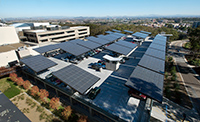 UC San Diego will be leaner in 2010 in a way that’s not related to state budget cuts, and it will be greener, too. Energy-efficiency improvements completed in 2009 reduced the campus carbon footprint by 7,955 metric tons a year. Beginning in 2010 and continuing for up to four years, 25 older buildings will also receive energy-saving retrofits that will reduce their carbon footprint by 4,000 metric tons a year. The completed and planned energy-efficiency projects will trim campus energy costs by a total of roughly $20 million a year. That’s another type of green we need in these economically lean times.
UC San Diego will be leaner in 2010 in a way that’s not related to state budget cuts, and it will be greener, too. Energy-efficiency improvements completed in 2009 reduced the campus carbon footprint by 7,955 metric tons a year. Beginning in 2010 and continuing for up to four years, 25 older buildings will also receive energy-saving retrofits that will reduce their carbon footprint by 4,000 metric tons a year. The completed and planned energy-efficiency projects will trim campus energy costs by a total of roughly $20 million a year. That’s another type of green we need in these economically lean times.
Health Sciences Expanding Mission with Major Constructions Projects
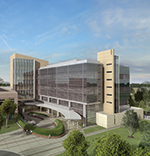 Health Sciences will expand its mission to improve health through research, education and patient care. Construction will continue throughout 2010 on the Sulpizio Family Cardiovascular Center, San Diego region’s first dedicated center for clinical care and research into heart disease and stroke; the Medical Education and Telemedicine Center, which will revolutionize medical training and be home to the Center for the Future of Surgery; and the Sanford Consortium Stem Cell Research facility, the realization of a unique vision among research partners on the La Jolla mesa to explore the promise of stem cells to deliver new cures and therapies. Health Sciences will expand its mission to improve health through research, education and patient care. Construction will continue throughout 2010 on the Sulpizio Family Cardiovascular Center, San Diego region’s first dedicated center for clinical care and research into heart disease and stroke; the Medical Education and Telemedicine Center, which will revolutionize medical training and be home to the Center for the Future of Surgery; and the Sanford Consortium Stem Cell Research facility, the realization of a unique vision among research partners on the La Jolla mesa to explore the promise of stem cells to deliver new cures and therapies.
New Center for Chronobiology Focuses on Sleep Disorders, Diabetes and Obesity
 The Division of Biological Sciences is establishing a multi-disciplinary Center for Chronobiology to study the circadian rhythms of plant, animal and human life. Understanding chronobiology is vital to our daily lives as one half of the population suffers from some problem in their daily sleep cycle. Medications, artificial lighting, shift work, airline travel, even 24/7 Internet access all represent chronobiological changes that affect our productivity and physical and mental well-being. The center’s researchers will investigate the role of circadian disorders in regulating the sleep-wake cycle, glucose stability and weight control with the long-term goal of developing new molecular treatments for patients suffering from disorders as diverse as insomnia, diabetes and obesity. The Division of Biological Sciences is establishing a multi-disciplinary Center for Chronobiology to study the circadian rhythms of plant, animal and human life. Understanding chronobiology is vital to our daily lives as one half of the population suffers from some problem in their daily sleep cycle. Medications, artificial lighting, shift work, airline travel, even 24/7 Internet access all represent chronobiological changes that affect our productivity and physical and mental well-being. The center’s researchers will investigate the role of circadian disorders in regulating the sleep-wake cycle, glucose stability and weight control with the long-term goal of developing new molecular treatments for patients suffering from disorders as diverse as insomnia, diabetes and obesity.
Sights on the Arts
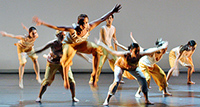 In 2010, the Division of Arts and Humanities will host the annual conference of the University of California's Institute for Research in the Arts. UCIRA supports UC artists dedicated to innovative approaches to form and content in the performing, media and visual arts. The 2010 gathering, slated for Nov. 18 through 21, is expected to draw representatives from all the UC campuses and will involve UCSD faculty, graduate and undergraduate students from the departments of visual arts, theatre & dance and music, as well as the program in creative writing. Conference content is still being developed but will include a variety of scholarly and public offerings, ranging from performances to discussions of such topics as arts philanthropy and digital media. It is the first time that UCSD has hosted such a conference. In 2010, the Division of Arts and Humanities will host the annual conference of the University of California's Institute for Research in the Arts. UCIRA supports UC artists dedicated to innovative approaches to form and content in the performing, media and visual arts. The 2010 gathering, slated for Nov. 18 through 21, is expected to draw representatives from all the UC campuses and will involve UCSD faculty, graduate and undergraduate students from the departments of visual arts, theatre & dance and music, as well as the program in creative writing. Conference content is still being developed but will include a variety of scholarly and public offerings, ranging from performances to discussions of such topics as arts philanthropy and digital media. It is the first time that UCSD has hosted such a conference.
Funding Future Student Ventures, Today
 The Rady School of Management is launching the Rady Venture Fund, a student-assisted venture capital investment fund. The three-course series allows Rady MBAs to work with investment industry leaders to manage the fund and deploy investment capital to help build new companies. The Rady Venture Fund will make one to two investments per year in seed-to-early stage companies in Southern California, primarily focused on high-tech, the life sciences and clean-tech. It is funded by donations to the UC San Diego Foundation. Any proceeds will revert to the fund and to the Rady School of Management to create a growing pool of investment capital or be used to build the Rady School endowment and support entrepreneurial programs at the school. Learn more at www.rady.ucsd.edu. The Rady School of Management is launching the Rady Venture Fund, a student-assisted venture capital investment fund. The three-course series allows Rady MBAs to work with investment industry leaders to manage the fund and deploy investment capital to help build new companies. The Rady Venture Fund will make one to two investments per year in seed-to-early stage companies in Southern California, primarily focused on high-tech, the life sciences and clean-tech. It is funded by donations to the UC San Diego Foundation. Any proceeds will revert to the fund and to the Rady School of Management to create a growing pool of investment capital or be used to build the Rady School endowment and support entrepreneurial programs at the school. Learn more at www.rady.ucsd.edu.
Students Flocking to Environmental Systems
Program, One of Fastest Growing Majors on Campus
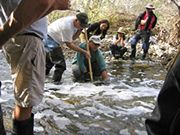 The Division of Physical Sciences is bringing together students, faculty and alumni in one of the fastest growing majors on campus for a research symposium May 12 that will showcase UC San Diego’s Environmental Systems, or ESYS Program. In eight years, the undergraduate environmental science and policy program has grown from a handful of pioneering students to more than 200 majors, many of whom have helped to improve the region’s environment by participating in yearlong internships and research projects with environmental and government agencies in San Diego. Through these real-life job experiences, students enter the local workforce or go on to graduate school prepared to grapple with some of the thorniest environmental challenges of the future. The Division of Physical Sciences is bringing together students, faculty and alumni in one of the fastest growing majors on campus for a research symposium May 12 that will showcase UC San Diego’s Environmental Systems, or ESYS Program. In eight years, the undergraduate environmental science and policy program has grown from a handful of pioneering students to more than 200 majors, many of whom have helped to improve the region’s environment by participating in yearlong internships and research projects with environmental and government agencies in San Diego. Through these real-life job experiences, students enter the local workforce or go on to graduate school prepared to grapple with some of the thorniest environmental challenges of the future.
New Resources and Services Boost Campus Research Enterprise
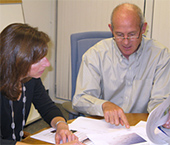 The work of scholars and scientists will be easier in 2010 thanks to new services and tools offered by Research Affairs. The new Research Proposal Development Service provides full-scale assistance to principal investigators and their teams as they prepare large, interdisciplinary proposals. Smaller proposals benefit from proposal-preparation advice and example-text that can be adapted for specific institutions or agencies. In addition, a new web-based reporting system, the Training Grant Administration System, makes it easier to apply for and receive NIH training grants. The work of scholars and scientists will be easier in 2010 thanks to new services and tools offered by Research Affairs. The new Research Proposal Development Service provides full-scale assistance to principal investigators and their teams as they prepare large, interdisciplinary proposals. Smaller proposals benefit from proposal-preparation advice and example-text that can be adapted for specific institutions or agencies. In addition, a new web-based reporting system, the Training Grant Administration System, makes it easier to apply for and receive NIH training grants.
Construction Projects Changing Campus Skyline
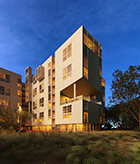 The new Health Sciences Neighborhood Graduate and Professional Housing project will be completed in fall 2010. About 452 unmarried graduate students will move into two-, three- and four-bedroom apartments in the School of Medicine “neighborhood” on the main campus. It will be composed of two backward L-shaped wings and a “green roof” that doubles as a social area. The development is one of six major projects under construction on campus in 2010, all of which are changing the skyline of the campus at a combined total cost of $568 million. The new Health Sciences Neighborhood Graduate and Professional Housing project will be completed in fall 2010. About 452 unmarried graduate students will move into two-, three- and four-bedroom apartments in the School of Medicine “neighborhood” on the main campus. It will be composed of two backward L-shaped wings and a “green roof” that doubles as a social area. The development is one of six major projects under construction on campus in 2010, all of which are changing the skyline of the campus at a combined total cost of $568 million.
NSF Awards $20 Million to the San Diego Supercomputer Center
to Develop Supercomputer that Relies on Flash Memory
 UCSD's San Diego Supercomputer Center (SDSC) will be at the forefront of high-performance computing by mid-2011 with a new supercomputer dedicated to solving critical science and societal problems now overwhelmed by the avalanche of data generated by the digital devices of our era. SDSC was recently awarded a five-year, $20 million grant from the National Science Foundation to build and operate an innovative system using a vast amount of flash memory to help speed solutions now hamstrung by slower spinning disk technology. Called Gordon, SDSC’s latest supercomputer will become a key part of a network of next-generation high-performance computers being made available to the research community through an open-access national grid, allowing researchers to tackle ‘data-intensive’ problems such as custom-tailored drug development, climate change prediction and simulations of the impact of earthquakes on structures. UCSD's San Diego Supercomputer Center (SDSC) will be at the forefront of high-performance computing by mid-2011 with a new supercomputer dedicated to solving critical science and societal problems now overwhelmed by the avalanche of data generated by the digital devices of our era. SDSC was recently awarded a five-year, $20 million grant from the National Science Foundation to build and operate an innovative system using a vast amount of flash memory to help speed solutions now hamstrung by slower spinning disk technology. Called Gordon, SDSC’s latest supercomputer will become a key part of a network of next-generation high-performance computers being made available to the research community through an open-access national grid, allowing researchers to tackle ‘data-intensive’ problems such as custom-tailored drug development, climate change prediction and simulations of the impact of earthquakes on structures.
Support for Student Scholarship, Front and Center at Scripps
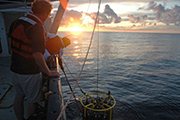 Scripps Institution of Oceanography shares the UC San Diego and UC systemwide mission of providing exceptional training and excellent education for our students. As part of the new UCSD campaign for student support, Scripps will continue its three-year effort to attract funding to recruit the best and brightest graduate students. Scripps students are the scientists who break new ground and make discoveries in areas such as climate change, biodiversity and conservation, and ocean engineering. In addition, attracting young and energetic postdoctoral fellows and new faculty to teach and mentor graduate and undergraduate students will pave the way for the next generation of stellar ocean and earth scientists. Scripps Institution of Oceanography shares the UC San Diego and UC systemwide mission of providing exceptional training and excellent education for our students. As part of the new UCSD campaign for student support, Scripps will continue its three-year effort to attract funding to recruit the best and brightest graduate students. Scripps students are the scientists who break new ground and make discoveries in areas such as climate change, biodiversity and conservation, and ocean engineering. In addition, attracting young and energetic postdoctoral fellows and new faculty to teach and mentor graduate and undergraduate students will pave the way for the next generation of stellar ocean and earth scientists.
Calit2 to Celebrate Tenth Anniversary
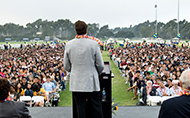 In 2010, Calit2 will celebrate its tenth anniversary. To mark the transition from fast-growing startup to what is now one of the world's largest and best-known interdisciplinary research institutions, Calit2 will unveil in March the first stage of a new strategic plan, focusing on four areas that are of vital concern to California because they will be transformed by the digital revolution: energy; the environment; health; and culture. Subsequently the institute will target the core technologies that will drive that digital transformation by building on Calit2's successful research efforts in its first decade, notably in wireless technologies, cyberinfrastructure, nanotechnology and MEMS (micro-electro-mechanical systems), and photonics. Calit2 will invite researchers from across the campus to propose and participate in specific research projects that align Calit2's technology agenda with the needs of California and its citizens in the decade ahead. In 2010, Calit2 will celebrate its tenth anniversary. To mark the transition from fast-growing startup to what is now one of the world's largest and best-known interdisciplinary research institutions, Calit2 will unveil in March the first stage of a new strategic plan, focusing on four areas that are of vital concern to California because they will be transformed by the digital revolution: energy; the environment; health; and culture. Subsequently the institute will target the core technologies that will drive that digital transformation by building on Calit2's successful research efforts in its first decade, notably in wireless technologies, cyberinfrastructure, nanotechnology and MEMS (micro-electro-mechanical systems), and photonics. Calit2 will invite researchers from across the campus to propose and participate in specific research projects that align Calit2's technology agenda with the needs of California and its citizens in the decade ahead.
Keeping Students Healthy, Thriving and Involved
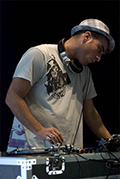 Students can look forward to a new year of social and intellectual pursuits. To ensure that UC San Diego students are healthy and thriving, the university is addressing their physical, psychological, emotional and spiritual needs with the campus Wellness Initiative. Students can get involved in the green revolution through the Sustainability Resource Center (src.ucsd.edu), a recently opened one-stop-shop where they can learn about green jobs, eco-friendly products and courses on sustainability-related topics. The campus hot spot is The Loft, which regularly hosts concerts, DJ parties and cultural events. And for sports fans, the RIMAC Annex is now open, complete with Peet’s Coffee, overlooking the renovated softball field—just in time for softball season. Students can look forward to a new year of social and intellectual pursuits. To ensure that UC San Diego students are healthy and thriving, the university is addressing their physical, psychological, emotional and spiritual needs with the campus Wellness Initiative. Students can get involved in the green revolution through the Sustainability Resource Center (src.ucsd.edu), a recently opened one-stop-shop where they can learn about green jobs, eco-friendly products and courses on sustainability-related topics. The campus hot spot is The Loft, which regularly hosts concerts, DJ parties and cultural events. And for sports fans, the RIMAC Annex is now open, complete with Peet’s Coffee, overlooking the renovated softball field—just in time for softball season.
UC San Diego’s Innovative Spirit Strengthens Alumni Community
 The UCSD Alumni Association, which has been recognized by national organizations for its creative use of technology, will continue to engage the alumni community with innovative technologies including a new website, iPhone application and increased use of social networking sites such as Facebook and LinkedIn. The website will highlight professional achievements and encourage alumni to join the new, enhanced online community – Triton Alumni Online – where they can connect with friends, create and customize a profile page, share class photos, upload a resume, search for a job and much more. The UCSD Alumni Association, which has been recognized by national organizations for its creative use of technology, will continue to engage the alumni community with innovative technologies including a new website, iPhone application and increased use of social networking sites such as Facebook and LinkedIn. The website will highlight professional achievements and encourage alumni to join the new, enhanced online community – Triton Alumni Online – where they can connect with friends, create and customize a profile page, share class photos, upload a resume, search for a job and much more.
Jacobs School Focusing on Developing Engineering Leadership
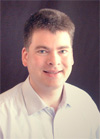 With the addition of the new Gordon Leadership Center, the Jacobs School of Engineering will now offer active mentorship and instructional programs aimed at developing leadership skills for engineers (and aspiring engineers) of all levels.
The Jacobs School is an active participant in the California State Summer School for Mathematics and Science (COSMOS), a four-week residential summer program on campus for high school students. Students work side-by-side with outstanding engineering faculty and researchers on a wide range of projects. Teams in Engineering Service (TIES) provides students with practical experience while serving the community. The Team Internship Program (TIP) connects multidisciplinary teams of Jacobs School students with industry partners, both in the United States and abroad.
With the addition of the new Gordon Leadership Center, the Jacobs School of Engineering will now offer active mentorship and instructional programs aimed at developing leadership skills for engineers (and aspiring engineers) of all levels.
The Jacobs School is an active participant in the California State Summer School for Mathematics and Science (COSMOS), a four-week residential summer program on campus for high school students. Students work side-by-side with outstanding engineering faculty and researchers on a wide range of projects. Teams in Engineering Service (TIES) provides students with practical experience while serving the community. The Team Internship Program (TIP) connects multidisciplinary teams of Jacobs School students with industry partners, both in the United States and abroad.
Building Bridges
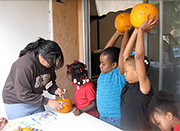 Officially recognized as a university center in late 2009, the Center for Community Wellbeing—led by Michael Cole and Bud Mehan of the Division of Social Sciences and Srinivas Sukumar of Calit2—will ramp up its efforts to build bridges between UCSD and the underserved population of Southeastern San Diego. The center engages the community in collaborative multidisciplinary research to improve education, health, economic development, neighborhood safety and community services. In 2010, the CCWB will continue nationally recognized work at Gompers Preparatory Academy, Lincoln High School and the Town & Country Village Learning Center. Plans for 2010 include installing a high-tech, interactive “video wall” at Town & Country, opening a health clinic at Lincoln High, staffed by UCSD School of Medicine, and creating a community council to enable full community participation in health science research. Officially recognized as a university center in late 2009, the Center for Community Wellbeing—led by Michael Cole and Bud Mehan of the Division of Social Sciences and Srinivas Sukumar of Calit2—will ramp up its efforts to build bridges between UCSD and the underserved population of Southeastern San Diego. The center engages the community in collaborative multidisciplinary research to improve education, health, economic development, neighborhood safety and community services. In 2010, the CCWB will continue nationally recognized work at Gompers Preparatory Academy, Lincoln High School and the Town & Country Village Learning Center. Plans for 2010 include installing a high-tech, interactive “video wall” at Town & Country, opening a health clinic at Lincoln High, staffed by UCSD School of Medicine, and creating a community council to enable full community participation in health science research.
IR/PS To Offer New One-Year Executive Master’s Degree
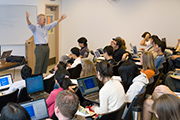 The Graduate School of International Relations and Pacific Studies (IR/PS) is launching a one-year executive master’s degree program in fall 2010. The Master of Advanced Studies in International Affairs program offers three career track options: international security; international political economy; and international public policy. “The graduate school not only has a strong academic reputation, but provides an opportunity to network with professionals in the private and public sectors from throughout the region,” says Stephan Haggard, faculty director of the new degree program. “Employers should also reap benefits from the program.” Application and program details can be found at http://irps.ucsd.edu/mas. The Graduate School of International Relations and Pacific Studies (IR/PS) is launching a one-year executive master’s degree program in fall 2010. The Master of Advanced Studies in International Affairs program offers three career track options: international security; international political economy; and international public policy. “The graduate school not only has a strong academic reputation, but provides an opportunity to network with professionals in the private and public sectors from throughout the region,” says Stephan Haggard, faculty director of the new degree program. “Employers should also reap benefits from the program.” Application and program details can be found at http://irps.ucsd.edu/mas.

|